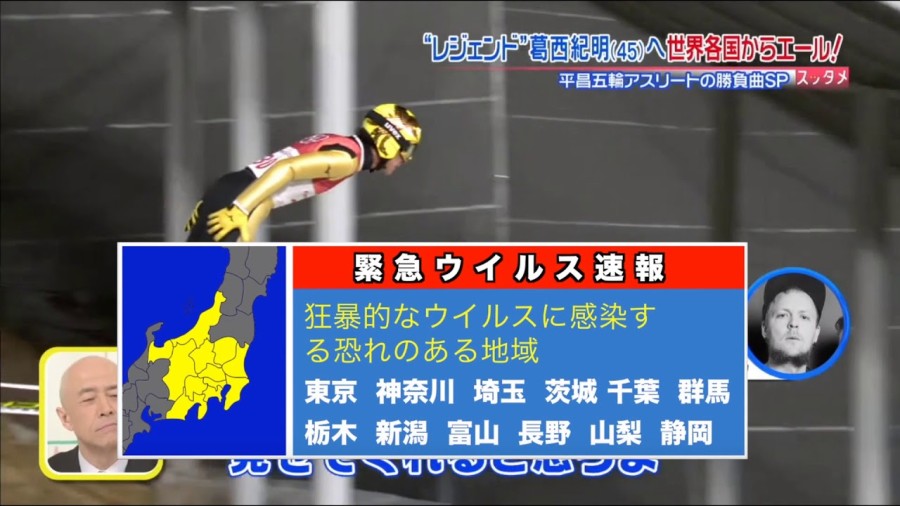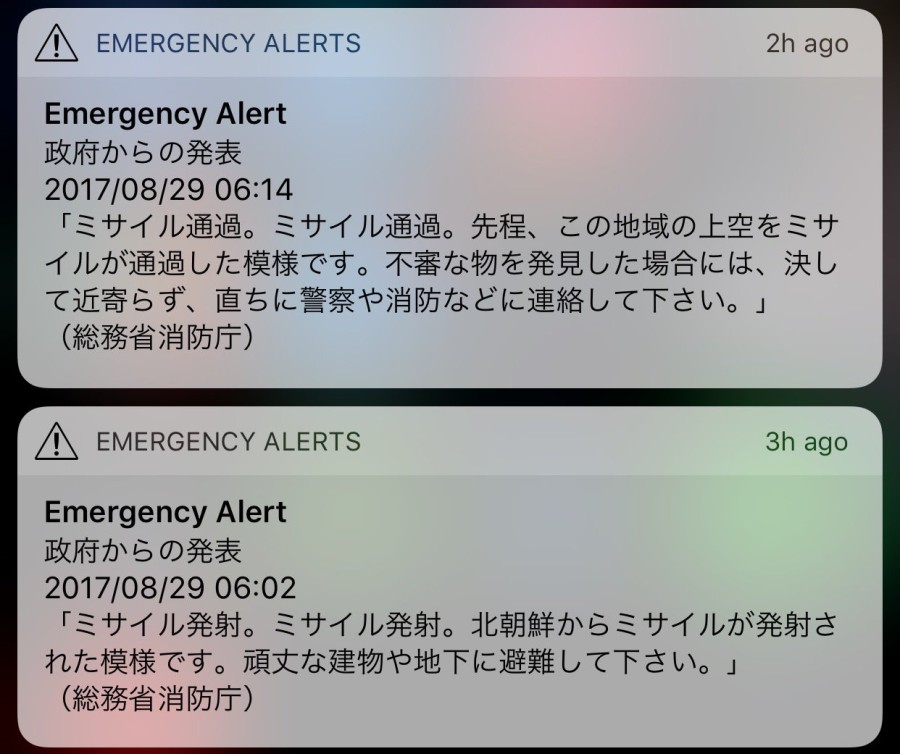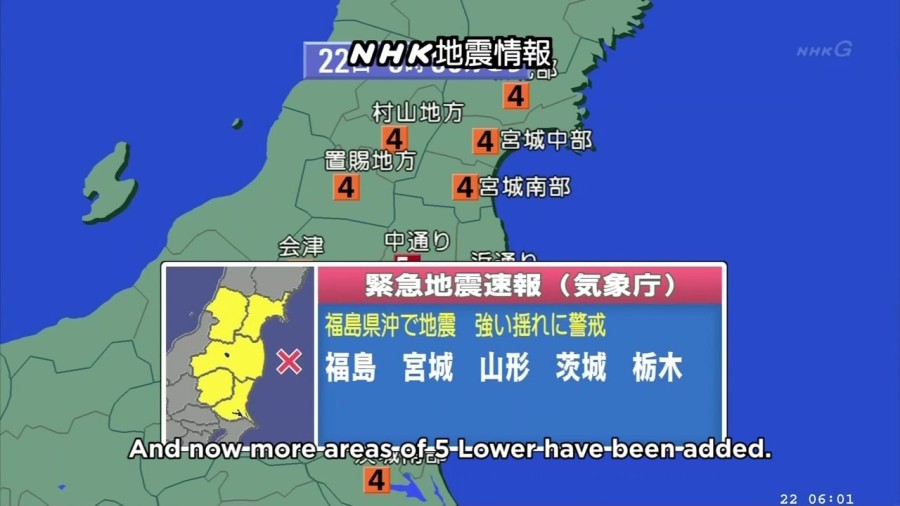You know that creepy earthquake alert ringtone? Remember that annoying warning while watching some Japanese Anime or TV show? In this article we are going to talk about Japan's famous Emergency Alert System known as EAS (Emergency Alert System) or J-Alert.
In Japanese it is also called Zenkoku Shunji Keihō Shisutemu/J Ararto [全国時報システム] which means something like Newsletter Alert for the Whole Country. What is J-Alert for? When and how does he appear?
Below we will leave the nostalgic music and scary for you to hear. The video also presents some interesting information about Japan EAS such as Alert levels:
Índice de Conteúdo
What is the Purpose of J-Alert or Japan EAS?
All countries have their EAS which literally means Emergency Alert System, but in Japan due to the increasing number of natural disasters, the system has become more efficient.
While in 1945 we had a Japan EAS through loudspeakers spread across the region, in February 2007 Japan launched the J-Alert with the aim of more quickly alerting the public to emergency threats.
The purpose of Japan EAS or J-Alert is warn about earthquakes, severe weather, volcanoes, missiles and other hazards. The system was developed to help with evacuation.

How does J-Alert work?
J-Alert is a satellite-based system that allows authorities to quickly broadcast alerts to local media and citizens directly through a system of nationwide loudspeakers, television, radio, email and cellular broadcasts. .
J-ALERT basically works like this:
The Fire and Disaster Management Agency (FDMA) receives information about an emergency situation such as a tsunami or missile attack.
FDMA offices in eastern Japan and/or western Japan transmit emergency information to J-ALERT receiving equipment via terrestrial satellite and backup circuits.
J-ALERT transmitters receive information and transmit it across the country in the form of:
- Ads from loudspeakers mounted on towers and buildings
- Alerts on TVs and radios
- Push alerts on cell phones
All notices except weather warnings severe, are broadcast in five languages: Japanese, English, Mandarin, Korean and Portuguese.

What Emergencies is Japan Alerts used for?
The J-ALERT system sends alerts as follows:
| Streaming | Alert Type |
|---|---|
| always automatic | Missile Launch, Terrorist Attack, Military Attack, Earthquake, Tsunami, Volcanic Eruption, Weather Emergency etc. |
| Automatic Depending on Location | Regional Details on Earthquake, Tsunami, Volcanic Eruption, Tornado, Flood etc. |
| not normally done | Specific river flood levels, weather warnings, volcano warnings, etc. |
List of Emergencies in Japan
Below is a list of possible emergencies that may receive some type of alert:
- Special emergency threats
- Quick updates on hypocenter, magnitude and precautions for a possible tsunami
- Volcanic Eruption Emergency Warning and Eruption Possibility
- Volcanic eruption warning and possibility of eruption
- Earthquake Forecast Warning for Tōkai Earthquakes
- Tsunami warning
- Tsunami warning
- weather warning
- Earthquake Early Warning
- Emergency warnings for heavy rain, heavy snow, gale, blizzard, waves and storm
- Warnings for heavy rain, heavy snow, gale, blizzard, waves and storm
- volcano eruption
- Great Tsunami Warning
- Earthquake Forecast Advisory Information from the Tōkai Earthquakes
- Tornado advisory information
- Ballistic missile information
- Earthquake prediction information from the Tōkai earthquakes
- Information about air strikes
- Information about guerrilla attacks and special forces
- Information about violent heavy rains
- Information on hypocenter, magnitude, intensities of various areas and presence of tsunami
- Information about the risk of landslides
- Information on large-scale terrorism
- Other information for civil and national defense
- volcanic crater forecast
- Flood forecast
- Severe weather.
- Earthquake
- Tsunami

Why is the Japan EAS Alert sound so bad?
Probably because of the old equipment from when the emergency transmission system was implemented. They never updated so it looks worse compared to modern equipment.
Another reason is probably to keep the default. If we look at the old alerts before J-Alert the sound was different, but it was horrendous. See below a video with all the Japan Alert sounds:
The article is still halfway through, but we recommend also reading:
Meaning of Japan Emergency Alerts
If you are a foreigner in Japan and for some reason you have not received the J-Alert message in your language, the word list below can help you identify the type of alert and how to evacuate.
| Japanese | Romaji | Meaning |
| 注意報 | chūihō | Advices |
| 警報 | keiho | Notices |
| 特別警報 | tokubetsu keihō | emergency notices |
| 気象情報 | kishō jōhō | Bulletins – provide information to supplement warnings and recommendations |
| 風雪注意報 | fūsetsu chūihō | Wind and snow warning |
| 強風注意報 | kyōfū chūihō | windstorm warning |
| 大雨注意報 | ōame chūihō | Heavy rain warning |
| 大雪注意報 | ōyuki chūihō | Heavy snow warning |
| 濃霧注意報 | nōmu chūihō | Dense fog warning |
| 雷注意報 | kaminari chūihō | storm warning |
| 乾燥注意報 | kansō chūihō | dry air warning |
| なだれ注意報 | nadare chūihō | avalanche warning |
| 着氷 | chakuhyō | Ice/snow accumulation warning |
| 霜注意報 | shimo chūihō | Frost warning |
| 低温注意報 | teion chūihō | low temperature warning |
| 融雪注意報 | yūsetsu chūihō | snow melt warning |
| 高潮注意報 | takashio chūihō | Storm increase warning |
| 波浪注意報 | harō chūihō | high wave warning |
| 洪水注意報 | kōzui chūihō | flood warning |
| 暴風警報 | bōfū keihō | storm warning |
| 暴風雪警報 | bōfūsetsu keihō | snow storm warning |
| 大雨警報 | ōame keihō | Heavy rain alert |
| 大雪警報 | ōyuki keihō | Heavy snow warning |
| 高潮警報 | takashio keihō | storm wave warning |
| 波浪警報 | harō keiho | high wave warning |
| 洪水警報 | kōzui keihō | flood warning |
| 海上風警報 | kaijōfū keihō | Close wind warning |
| 海上強風警報 | kaijō kyōfū keihō | windstorm warning |
| 海上暴風警報 | kaijō bōfū keihō | storm warning |
| 海上台風警報 | kaijō taifū keihō | typhoon warning |
| 海上濃霧警報 | kaijō nōmu keihō | Dense fog warning |
| 海上着氷警報 | kaijō chakuhyō keiho | ice warning |
| 海上うねり警報 | kaijō uneri keihō | sea ripple warning |
| 地震情報 | jishin jōhō | earthquake information |
| 震度速報 | shindo sokuho | seismic intensity information |
| 震源に関する情報 | shingen ni kan suru jōhō | earthquake information |
| 震源震度に関する情報 | shingen / shindo ni kan suru jōhō | Earthquake and seismic intensity information |
| 各地の震度に関する情報 | kakuchi no shindo ni kan suru jōho | Seismic intensity information at each location |
| 遠地地震に関する情報 | enchi jishin ni kan suru jōho | Distant information about earthquakes |
| 緊急地震速報 | kinkyū jishin sokuho | earthquake early warning |
| 津波情報 | tsunami jōhō | Tsunami information |
| 津波予報 | tsunami yohō | Tsunami forecast |
| 津波注意報 | tsunami chūihō | Tsunami warning |
| 津波警報 | tsunami keiho | Tsunami warning |
| 火山情報 | kazan jōhō | volcano information |
| 噴火予報 | funka yohō | volcanic forecast |
| 噴火警報 | funka keiho | volcanic warning |
| 洪水予報 | kōzui yohō | Flood forecast |
| 台風情報 | taifū jōhō | typhoon information |
| 風速 | fūsoku | Wind Speed - Usually expressed in meters/second |
| 余震 | yoshin | Aftershocks – These earthquakes occur after the main earthquake and vary in size and frequency. It can continue for several days and even occur many months after an earthquake. |
| 洪水 | kōzui | floods |
| 浸水 | shinsui | Inundation |
| 崖くずれ | gake-kuzure | Landslide – Earth and sand on steep slopes crumble and fall due to heavy rains or earthquakes. |
| 土砂くずれ | dosha-kuzure | Mud Slide – A mass of mud and other land material falls down a slope or other slope. |
| 警戒 | keikai | Vigilance/Warning/Caution - To be careful |
| 通行止め | tsūkō-dome | Road interdiction / inability to pass |
| 避難 | hinan | Evacuation - To escape to a safer place during a disaster. |
| 避難所 | hinan-jo | Shelter / Refuge / Evacuation Center – Places where those who have lost their homes due to a disaster can temporarily stay. |
| 避難場所 | hinan-basho | Evacuation Area – Places to temporarily evacuate during a disaster. |
| 避難勧告 | hinan-kankoku | Evacuation Notice – A recommendation to evacuate as announced by the mayor. This occurs in situations where the possibility of harm to people is high. |
| 避難指示 | hinan-shiji | Evacuation instruction – This is given when danger is imminent and is stronger than hinan-kankoku. |
| 被災者 | hisaisha | disaster victim |
| 安否確認 | anpi-kakunin | security confirmation |
| 行方不明 | yukue-fumei | The whereabouts of a person is unknown |
| 非常食 | hijō-shoku | Emergency rations (food) |
| 停電 | teiden | Blackout / power outage |
| 断水 | dansui | Waterfall |







